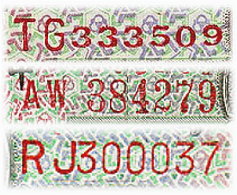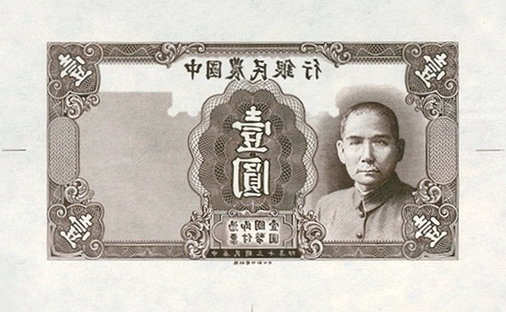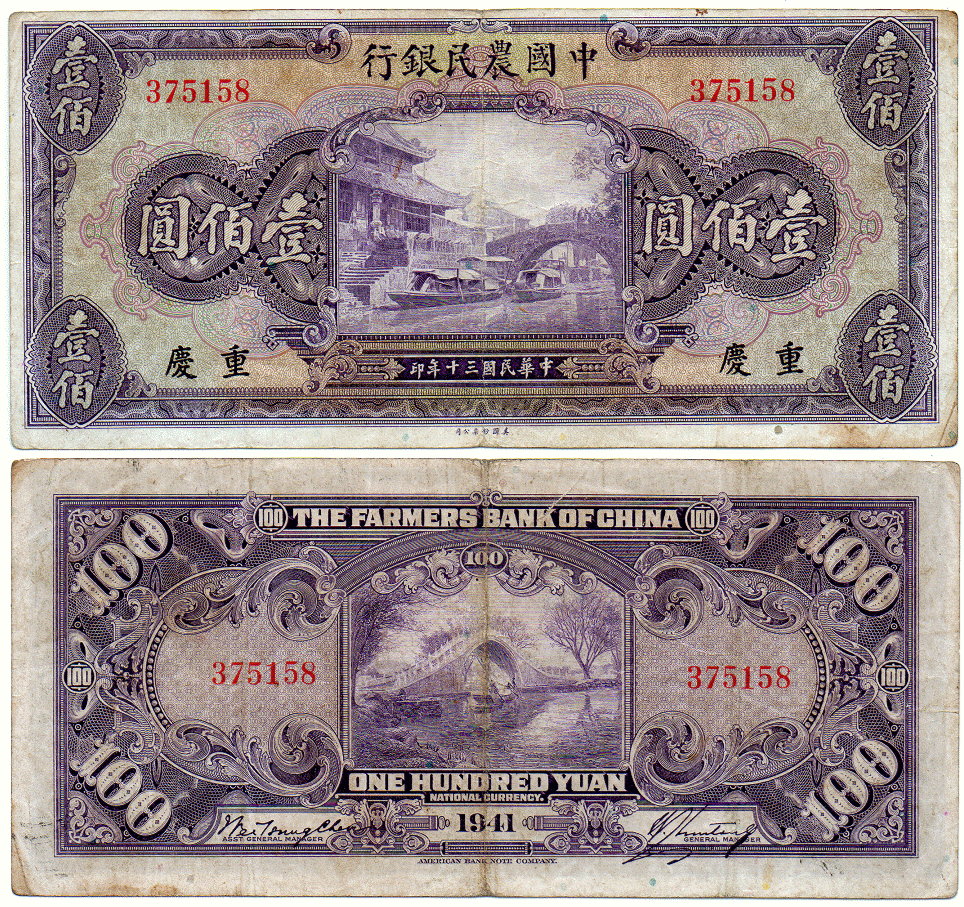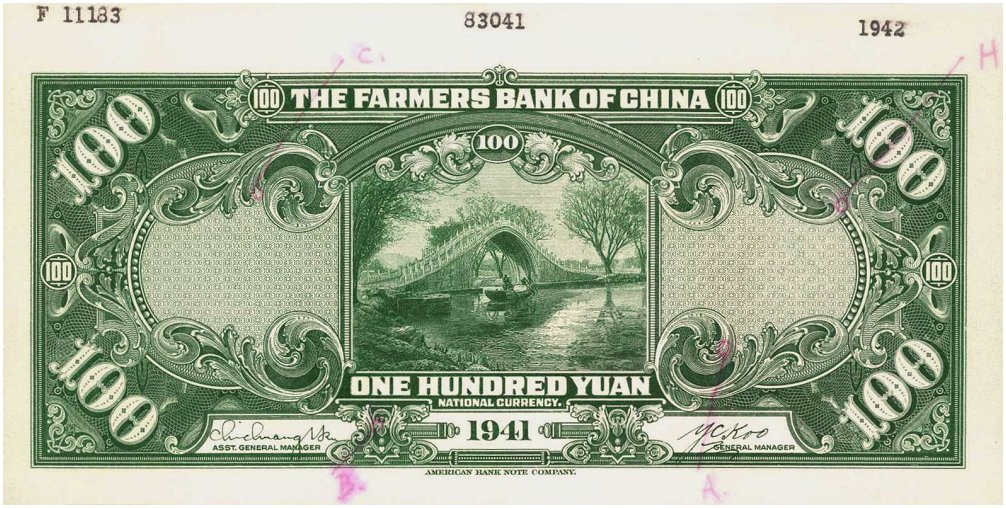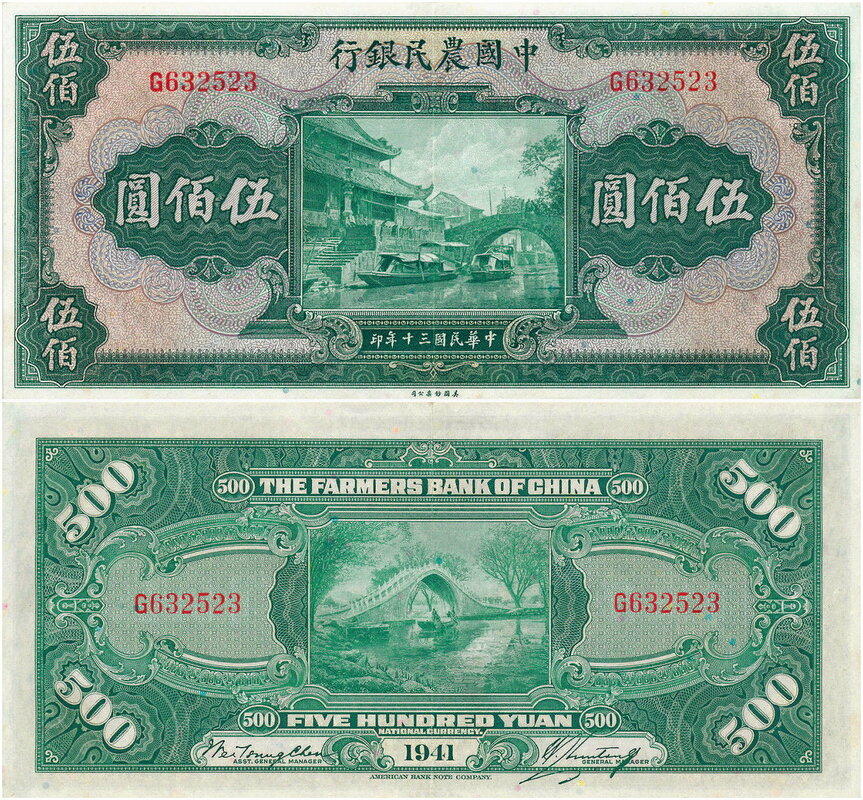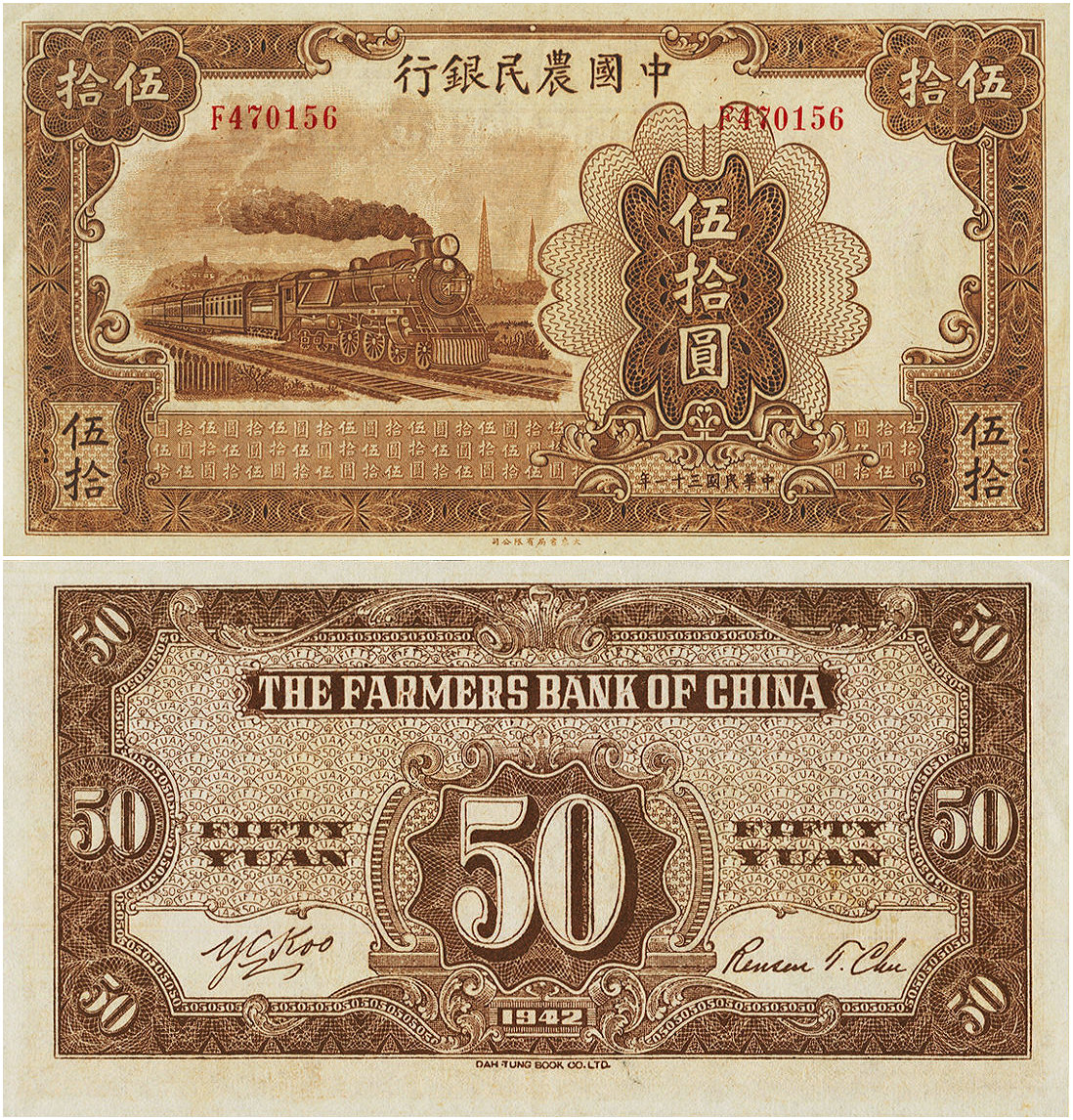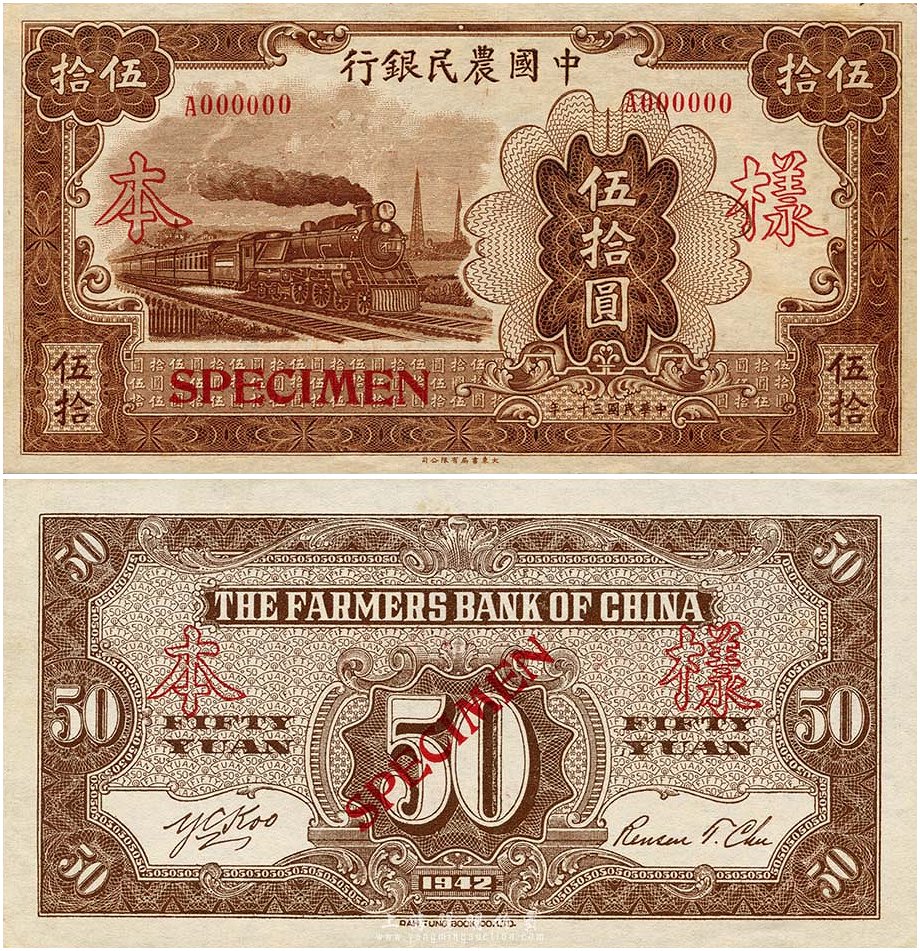|
Created January 2019
|
The Farmers Bank of China - 中國農民銀行
Section 3
The 1941 De La Rue issue - 年十三國民華中
|
Essentially an update of the 1 and 5 yuan notes of the 1935 series. Lithographic printing by several offsite printers contracted to De La Rue, due to the Blitz damage suffered by De la Rue's main factory. This is presumably the reason for the three serial number varieties found on both denominations (right)
The classical agricultural scenes of the front have been replaced by the portrait of Dr Sun Yat-sen. The colours have also been changed, however the border frame, underprint and other details are identical. The back is almost identical and continues the vignettes of the 1935 issues. Other than the change of colour, the two main differences are the enlarged watermark 'window' at the left, and the lack of serial numbers. The signatures are now engraved. Please see under the 1935 series in section one for details regarding the vignettes on the back of these two notes. |
|
1 yuan (National Currency)
Brown. Green and multicolour underprint. Three serial number varieties. (front) portrait of Dr Sun Yat-sen at left. (back) The Clock (bell) Tower of Fayu Temple, Putuo Mountain, Zhoushan, Chekiang (Zhejiang). A vignette of horned sheep at the right. - please see the 1935 issues for further details regarding the reverse. Watermark: portrait of Dr Sun Yat-sen Printer: Thomas De La Rue & Company Ltd, London. 德纳罗印钞公司 Type 1 (Krause SCWPM P 474, Smith & Matravers C290-80). Signatures (engraved): Gu Yiqun (Acting General Manager) - Xu Jizhuang (Assistant Gen. Manager) Type 2 Specimen(s) Type '3' Right: probably a printers developmental piece for the 1941 1 yuan note. This carries an unknown pair of engraved signatures. This note still retains the Chinese date of the original 1935 issue which may mean that it was part of the process of creating the issued 1941 note, rather than for a later 2nd issue which failed to appear. If so, then the signatures may not even be of Farmers Bank officials, but merely applied as an example of how the finished note will look. The serial number prefix QB could indicate this was intended for a 2nd issue, however again, the 1935 version 1 yuan ended it's run with serial prefix 'QF'. Below: recently auctioned by Spink; an unusual mirror-image printers specimen of unknown purpose?! |
|
5 yuan (National Currency)
Blue. Three serial number varieties. (front) portrait of Dr Sun Yat-sen at left. (back) The Fuling tomb, of the Manchu Tombs at Mukden (Shenyang), formerly Manchuria. A vignette of a cow at right. - please see the 1935 issues for further details regarding the reverse. Watermark: portrait of Dr Sun Yat-sen Printer: Thomas De La Rue & Company Ltd, London. 德纳罗印钞公司 Type 1 (Krause SCWPM P 475, Smith & Matravers C290-81). Signatures (engraved): Gu Yiqun (Acting General Manager) - Xu Jizhuang (Assistant Gen. Manager) Type 2 Specimen |
Chinese notes and U-Boats
Newbiggin by the Sea, a coastal town above Newcastle, in Northumberland, UK; was involved in a series of incidents during the Second World War. One such event occurred during the early years of the war when, unbeknown to everyone, a German submarine was based in Newbiggin Bay, a few hundred yards from the beach. The story was substantiated by the German captain of the U-Boat who came to stay at the Old Ship Inn soon after the end of hostilities.
The submarine's mission was to wait for vessels leaving the Port of Tyne and then sink them. One such ship was loaded with Chinese banknotes manufactured by WD & HO Wills, on behalf of Thomas De La Rue, which had a factory on the Coast Road. This was one of the orders which De La Rue had been unable to complete at it's own London Bunhill Factory due to bomb damage, and included these notes of the 1941 series of the Farmers Bank. Hours after the ship was attacked, parts of her cargo began to come ashore on the north-east coast with Newbiggin being one of the major beneficiaries. This came to light when several local pupils who attended the school in Ashington began to bring whole wads of this currency into classrooms.
A Bevin Boy (young British men conscripted to work in the coal mines of the United Kingdom, from December 1943 until 1948) based at Ashington, later managed to pass one off as a ten shilling note at the Grand Hotel.
Source: Newbiggin Town Council (they have removed the online article unfortunately).
Newbiggin by the Sea, a coastal town above Newcastle, in Northumberland, UK; was involved in a series of incidents during the Second World War. One such event occurred during the early years of the war when, unbeknown to everyone, a German submarine was based in Newbiggin Bay, a few hundred yards from the beach. The story was substantiated by the German captain of the U-Boat who came to stay at the Old Ship Inn soon after the end of hostilities.
The submarine's mission was to wait for vessels leaving the Port of Tyne and then sink them. One such ship was loaded with Chinese banknotes manufactured by WD & HO Wills, on behalf of Thomas De La Rue, which had a factory on the Coast Road. This was one of the orders which De La Rue had been unable to complete at it's own London Bunhill Factory due to bomb damage, and included these notes of the 1941 series of the Farmers Bank. Hours after the ship was attacked, parts of her cargo began to come ashore on the north-east coast with Newbiggin being one of the major beneficiaries. This came to light when several local pupils who attended the school in Ashington began to bring whole wads of this currency into classrooms.
A Bevin Boy (young British men conscripted to work in the coal mines of the United Kingdom, from December 1943 until 1948) based at Ashington, later managed to pass one off as a ten shilling note at the Grand Hotel.
Source: Newbiggin Town Council (they have removed the online article unfortunately).
The 1941 American Banknote Co issue - 年十三國民華中
The 1941 series of three denominations; 50, 100 and 500 yuan, were the only notes produced by the American Banknote Company for the Farmers Bank of China.
The Chungking 重慶 (Chongqing) overprint issues circulated earlier than those without, as is confirmed by the signatures of the bank officials. Which may explain why there are no known 'non-Chungking' 50 yuan notes despite their listing in both Smith & Matravers and the SCWPM; their existence is probably assumed on the basis of the 100 yuan.
Also, hard to determine, but Chinese source seems to indicate that the ABNC series was wholly or partially unauthorised by bank officials which may explain the lack of red seals which seem to relate to the Ministry of Finance? A further point of interest is that when these notes were issued, the General Manager Ye Zuotang, whose engraved signature appears on the back had already left office (was indeed deceased), showing that the notes must have been planned and printed in 1940.
The American Banknote Co. copyright mark located on the front vignette occurs at the very lower left, where the steps meet the water of the canal. On the back, the mark occurs on a rock at the bottom centre of the vignette, just above the 'T' in 'FIFTY' or the 'ND' in "HUNDRED".
|
50 yuan, 100 yuan, 500 yuan (National Currency)
50 yuan: Brown with multicolour underprint. 100 yuan: Purple with multicolour underprint. 500 yuan: Green with multicolour underprint. (front) the Ziwei bridge and Huili Temple, Jiaxing/Haining. The temple was rebuilt twice in the 20th century, most recently in the 1980s. (back) Yudai or ‘Jade Belt’, a ‘moon bridge’ in the grounds of the Imperial Summer Palace, built during the reign of Emperor Qianlong c.1760 - Peking/Beijing. The scene is copied from a photo by Donald Mennie from his photo album 'The Pageant of Peking' published in the 1920s. (see below right) Watermark: none Printer: American Banknote Company 美国钞票公司 50 yuan: Type 1 (Krause SCWPM P 476b, Smith & Matravers C290-82a). Regional/branch overprints for Chungking 重慶 (Chongqing) Serial numbers on both sides (see above right). Signatures (engraved): Chen Huaizhong (Assistant Gen. Manager) - Ye Zuotang (General Manager) - Type '2' (Krause SCWPM P 476a, Smith & Matravers C290-82b). No regional/branch overprints. Though listed by Smith and Matravers (and repeated by the SCWPM) there is no evidence for this variety. Type 3 Specimen(s)
100 yuan:
Type 1 (Krause SCWPM P 477b, Smith & Matravers C290-83a). Regional/branch overprints for Chungking 重慶 (Chongqing) Serial numbers on both sides. (right) Signatures (engraved): Chen Huaizhong (Assistant Gen. Manager) - Ye Zuotang (General Manager) - Type 2 (Krause SCWPM P 477a, Smith & Matravers C290-83b). No regional/branch overprints. Serial numbers on front only. (right) Signatures (engraved): - Xu Jizhuang (Assistant Gen. Manager) - Gu Yiqun (General Manager) Type 3 Specimen(s).
Right: Colour trial of Type 2 in green, showing the location of hidden security features (letters). 500 yuan:
Type 1 (Krause SCWPM P 478b, Smith & Matravers C290-84-). Regional/branch overprints for Chungking 重慶 (Chongqing) Serial numbers on both sides. Only known as a specimen. (right) Signatures (engraved): Chen Huaizhong (Assistant Gen. Manager) - Ye Zuotang (General Manager) - Type 2 (Krause SCWPM P 478a, Smith & Matravers C290-84). Serial numbers on both sides. Signatures (engraved): Chen Huaizhong (Assistant Gen. Manager) - Ye Zuotang (General Manager) - Right: the 500 Yuan is known with what are anti-Japanese propaganda overprints:
抗日建國 (Anti-Japanese Nation Building) |
The 1942 issues - 年一十三國民華中
50 and 100 yuan; the last two true banknotes ever issued by the bank. Later issues are cashiers cheque type notes for local use.
The 50 yuan is an emergency issue clearly created from plates originally intended for the Bank of Communications alone. Almost identical 50 yuan notes were issued in different colours for the Farmers Bank, the Bank of Communications and the Bank of China. The 50 yuan would seem to be a later printing than the 100 Yuan, as the signature of the assistant manager has changed.
The 50 yuan is an emergency issue clearly created from plates originally intended for the Bank of Communications alone. Almost identical 50 yuan notes were issued in different colours for the Farmers Bank, the Bank of Communications and the Bank of China. The 50 yuan would seem to be a later printing than the 100 Yuan, as the signature of the assistant manager has changed.
|
50 yuan
Printed in Chungking. Brown. (front) steam train, with masts to the right, and a pagoda crowned hilltop city in the far distance. (back) English title and denomination Watermark: none Printer: Dah Tung Book Co. Ltd 大東書局有限公司 Type 1 (Krause SCWPM P 479, Smith & Matravers C290-90). Signatures (engraved): Gu Yiqun (Acting General Manager) - Zhu Runsheng (Assistant Gen. Manager) Type 3 Specimen(s). (Right) |
|
100 yuan
Printed in Chungking. Green. (front) ‘classical’ agricultural scenes originally from the Southern Song Dynasty 'Yuzhi gengzhi tu' (Imperially Commissioned Illustrations of Agriculture and Sericulture/Tilling and Weaving). This is an extended version of the scene used on the 20 cents of 1937 SCWPM P 462. For details see this listing in Section 2. (back) English title and denomination Watermark: none Printer: Tah Yeh (Dah Yip) Co, 中国大(?)公司 Type 1 (Krause SCWPM P 480, Smith & Matravers C290-91). Signatures (engraved): - Xu Jizhuang (Assistant Gen. Manager) - Gu Yiqun (General Manager) Type 3 Specimen(s). (Right) |
-
